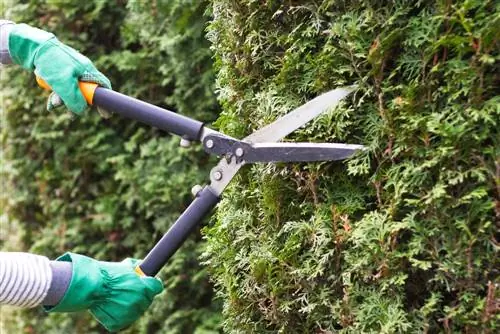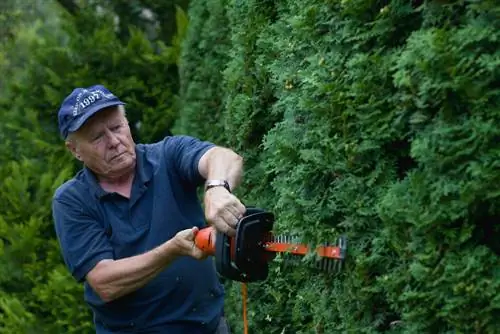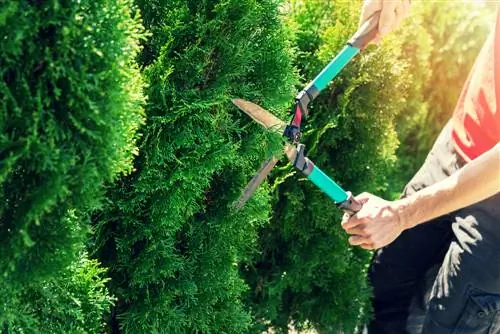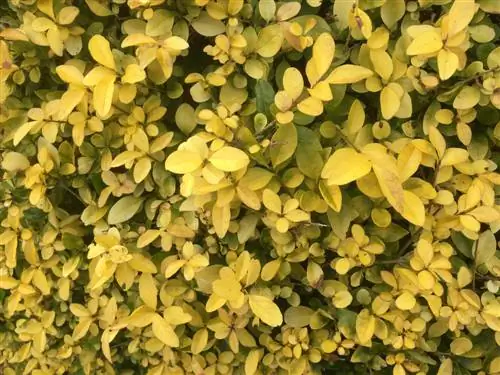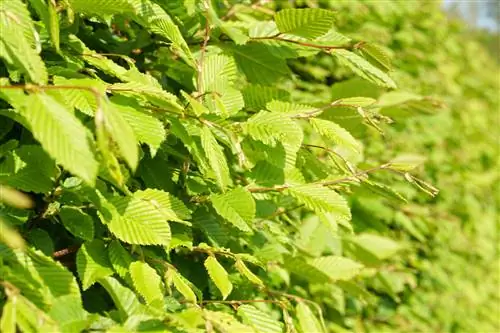- Author admin [email protected].
- Public 2023-12-16 16:46.
- Last modified 2025-06-01 06:02.
The much-praised pruning tolerance of Thuja is limited to a narrow, green needle coat. If the inexperienced home gardener does not exercise caution when cutting, the tree of life will end up with bare, brown spots and dark holes. After reading this pruning tutorial you will be familiar with the perfect pruning care for Thuja as a solitary plant and hedge. This is how you cut the popular evergreen correctly.
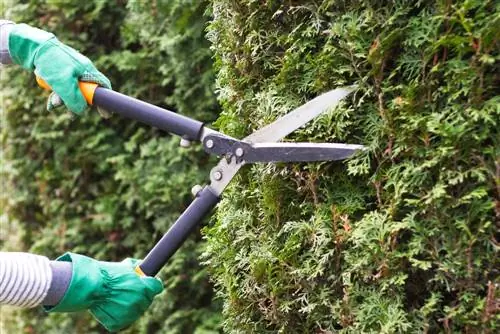
How to cut thuja correctly?
In order to cut Thuja correctly, you should always cut in the green needled shoot area and pay attention to regular, moderate pruning care. Avoid cuts that are too deep and radical rejuvenation cuts to prevent permanent gaps or brown spots.
Why is cutting thuja so delicate?
Tree nurseries and garden centers offer the tree of life as a pruning-friendly, evergreen ornamental tree. Of course, one careless moment is enough to permanently disfigure a thuja. As an introduction to the tutorial, we will examine the question of why cutting Thujen requires a careful approach:
- Thuja only grows at the tips of the shoots
- Other woody areas have stopped growing forever
- Tree of life species does not have sleeping eyes as an “iron growth reserve”
If you cut back a thuja once, you will regret the mistake for the rest of your life. The conifers no longer sprout from old wood. There are permanent gaps that allow a view of the dried-out interior of the bush. On arborvitae hedges, brown spots spoil the appearance and no longer turn green. This rule of thumb applies to every type of cut on Thujen:Always cut in the green needled shoot area
Cutting correctly for shape and vitality - cutting types at a glance
Uncut, a western arborvitae stretches 10 meters or more in height and becomes a spacious 3 to 4 meters wide. Even the slender Thuja variety 'Smaragd' reaches a height of up to 6 meters. With these dimensions, the conifers quickly reach their limits in the normal garden. Given the reservations about deep pruning explained above, regular, moderate pruning care regulates growth and preserves evergreen vitality. The following table lists all suitable types of pruning for the tree of life as a solitary plant and hedge:
| Cut style | Target | best date |
|---|---|---|
| Build-up cut solitaire and hedge | even growth, better stability against snow pressure | February to early March |
| Topiary hedge | Growth control, shape maintenance | February to early March |
| Care cutting Thuja hedge | Form retention | End of June to mid-July |
| Form and thinning cut solitaire | Remove dead wood, preserve shape | February to early March |
Arejuvenation cut, as you know it from deciduous trees, isnot part of the pruning care of Thujen. Regular pruning acts as continuous rejuvenation so that a tree of life does not become bare or too large.
Set up a Thuja solitaire with a stable base structure
Upright-growing Thuja species thrive with several scaffolding shoots that compete with each other. Each shoot strives - as quickly as it can - towards the exposed outside and from there upwards. This creates a one-sided weight shift from an early age. When there is snow pressure or strong wind, the shoots simply fall apart. With a successive build-up cut, you create a stable scaffolding structure that will not weaken under loads in later years. How to do it professionally:
- Let the 3 strongest ground shoots grow upwards uncut as the Thuja center
- Derive side shoots to lower, short shoots
- Pull off onto a staircase-like structure of side shoots around the scaffolding center
It is important to note when making the cut that you limit yourself to the green shoot area when making the derivation cut. Do not wait until you can only redirect outer scaffold shoots into the brown area before making the build-up cut. In this case it is too late and you should delete the cut type from the care program without replacing it.
Background
Capping the middle shoot tip stops height growth
If you want to stop the height growth of a thuja, cut off the tips of the three leading scaffold shoots. The growth law of top funding is applied. This means that a plant always grows strongest on its top buds. A large part of the reserve substances is transported to the top buds because there it goes towards sunlight. As soon as the top buds are cut off, the tree of life stops growing in height and increasingly sprouts from deeper buds. You shouldnot behead a tree of life that has reached its final height It is better if you redirect the top of the plant to a lower positioned side branch, which acts as a new tip.
Thuja rarely cut as a solitary eye-catcher
A thuja with a stable skeleton thrives excellently without annual pruning. As the image below suggests, pruning care addresses long or heavily drooping branches when necessary. This is how the shape and maintenance cut works:
- Best time is in February
- Tighten out previously dead shoots inside
- Derive branches that stick out of the shape or are arched overhanging
- Place the scissors at the fork of old and young wood
So that the removal of individual branches does not leave a gap, proceed as follows: Bend the branch in question to the side. Use this trick to check whether the cut creates a gap or bald spot. If this is the case, choose an intersection point further out.
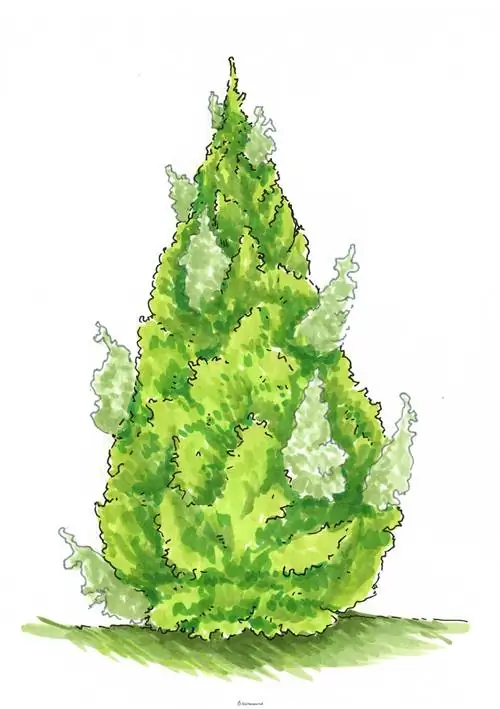
If a tree of life becomes too large or individual side shoots hang over, a drainage cut solves the problem. Redirect the affected branches to a shorter, upright side shoot.
Excursus
Cut thuja sculptures often and with a stencil
Experienced home gardeners know that when it comes to plant care, there are no rules without exceptions. When cutting Thuja, the premise applies to the topiary of solitary sculptures. You can give balls, cones, pyramids and figures a harmonious shape by making frequent cuts and using stencils. When making the build-up cut, place the template over the tree of life and cut within the green shoot area. Gradual construction creates a dense, bushy and dimensionally stable green work of art. From spring to autumn, the scissors are used as often as the progressive growth requires.
Building a tree of life hedge - this is what you should pay attention to
It takes years of patience to build a thuja hedge with a privacy function. Even a knee-high fence or bed border doesn't form overnight. In contrast to deciduous shrubs such as hornbeams or cherry laurel, cutting errors are obvious to any observer for half an eternity. Dedicate yourself to pruning your tree of life hedge with calmness and create an evergreen showpiece for your garden. How to do it professionally:
- Blend at least twice a year: February and June (optional: again at the end of August)
- Cut thenew growth back to 3, 4 or 5 centimeters
- Cut off weak and inward-facing branches
- Train thuja hedge in a trapezoid shape: wide base and narrow hedge crown
- Stretch cords along the hedge for orientation
As illustrated in the illustration below, please give your arborvitae hedge aconical shape right from the start Because the surface is narrower than the base, the evergreen wall thrives when flooded with light and densely needled. Furthermore, less snow remains on the hedge bushes and the tightly upright scaffolding shoots do not fall apart as quickly. Reliable dimensional stability is only achieved through the gradual build-up cut, as recommended in this tutorial.
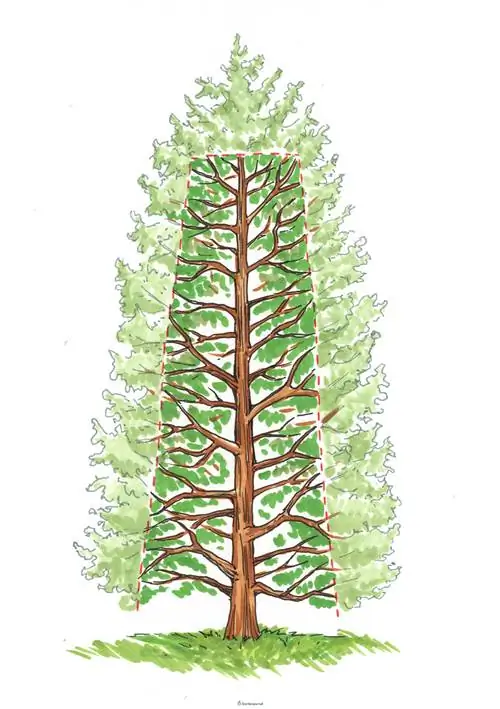
A thuja hedge is always built in a trapezoid shape. If the build-up cut is done twice a year, there is no risk of having to cut into the unneeded area.
Cut the thuja hedge into shape in February
If the pruning leaves the thuja hedge at the desired final height, annual topiary pruning will preserve the achieved result. Choose afrost-free, overcast day in February. As a result, your hedge will maintain its well-groomed appearance for many weeks. The late winter pruning time is also the best opportunity to thin out dead wood and weak branches. How to do it right:
- Start by thinning out dead wood and inward-facing shoots with one-handed scissors or a saw
- Stretch cords as guide lines for an accurate cut in a trapezoid shape
- Take the hedge trimmer in your hand and set it up with a view of the uncut hedge area
- With your arms stretched, swing a motorized shear evenly up and down parallel to the hedge
- Hedge crown with horizontal knife bar cut from the back by pivoting movements
Always cut in the green needled shoot area to avoid brown spots and holes in the hedge appearance. In contrast to the build-up phase, only a few millimeters of the green coat should remain. If only 1 centimeter of shoot length is added per topiary and side, your arborvitae hedge will widen by a space-consuming 20 centimeters within 10 years. All considerations and measures to maintain the correct distance from neighboring property are then no longer applicable.
Excursus
The right tool for every type of cut
When you cut a solitary thuja, the cut focuses on individual shoots that need to be removed or cut back. In this case, one-handed pruning shears should be ready to hand, either as bypass or anvil shears. Topiary cutting of a green tree of life sculpture is achieved perfectly with sheep scissors. A knee-high thuja border looks at its best when you use cordless shrub shears to cut it. You can trim the green wall of an arborvitae hedge accurately and effortlessly with an electric hedge trimmer, provided there is a power outlet nearby. Hedges longer than 10 meters call for a petrol-powered hedge trimmer because cordless devices lack the capacity and electric trimmers end up in a tangled mess of cables.
Care cut only when necessary - this is how it works
To maintain the shape of a majestic arborvitae hedge, it is an advantage if you use the hedge trimmer againat the end of June. Thujas grow denser and bushier the more often you cut them. Tension the cords again as marking lines for the advantageous trapezoid shape. Skillful pruning is limited to shoots that protrude from the shape of the hedge. In the summer, do not cut off more growth than has been added since the beginning of spring.
For slow-growing Thuja Smaragd, this year's pruning care is finished at the end of June (St. John's Day). If it is a stronger-growing arborvitae hedge, such as Thuja Brabant, it is your horticultural decision to cut it for the last time inAugust before winter. The hedge trimmer should rest from the beginning of September so that regrowing branches mature in time before the first frost.
Background
Check the thuja hedge for nesting birds before each cut
The perfectly maintained arborvitae hedge offers birds ideal conditions for summer breeding. Carefully examine the hedgebefore each pruning for inhabited bird nests. If you find what you are looking for, the cutting date will be postponed until autumn or next spring. With this approach, you not only act responsibly, but also in compliance with the law. According to the Federal Nature Conservation Act, light pruning is only permitted between March 1st and September 30th if there are no breeding birds in the wood.
Frequently asked questions
Is it possible to keep the western arborvitae (Thuja occidentalis) to a height of 400 centimeters and a width of 80 centimeters?
This is possible without any problems. However, education cannot be done retrospectively on an old tree of life. If you shorten an established thuja significantly and cut right down to the brown wood, it will not sprout again from the inside. However, if you start training a freshly planted tree of life and limit your annual pruning to the green area, it will thrive even when it is 80 centimeters narrow and dense.
My trees of life have visibly turned brown from the inside out this year. Outside, the thujas were always nice and green. I shook the bushes a bit and many brown needles fell to the ground. Is that normal? Am I doing something wrong?
Yes, that's completely normal. Like all conifers, Thujen thrive in densely needled conditions. Inside, the needles often turn brown due to the lack of light. A tree of life basically only has a “green coat”. This aspect is important when editing. Please always measure the cutting depth so that green needles are retained. If you cut too deeply, the branches will die and an unneedled branch will stop growing.
I would like to plant Thuja 'Smaragd' in a bucket as a privacy screen for the terrace. What should you pay attention to? Which bucket size is right?
In order for Thuja 'Smaragd' to thrive in the pot, it is important to have a consistent supply of water and nutrients. To prevent a tree of life from tipping over in the wind, the container should always be wider than the bush. Unless you prune the plant regularly, a container will need to be enlarged every few years. To start, we recommend a pot volume of 30 liters.
My Thuja hedge has gotten way too big. It is nice and dense and green on the sides. Can I trim the hedge?
If the arborvitae hedge has grown too high for you, there is nothing wrong with cutting more heavily along the hedge crown. Stretch a string in advance to mark the straight line of the cut. Then cut the individual Thuja trunks back to the desired height. From a bird's eye view, the hedge crown appears bare and patchy. You can assume that vigorously growing side branches will close the crown again within a few years. We recommend that you cut the arborvitae at maximum eye level in order to remove the bare branches from view.
Are thujas poisonous?
Unfortunately, all Thuja species are poisonous garden plants. Toxins are contained in all parts of the plant. The highest concentration is in the shoot tips. Intentional or unintentional consumption can lead to nausea, vomiting and even liver and kidney failure. Direct skin contact with the plant sap causes allergic reactions. Wear gloves, safety glasses and long-sleeved clothing when carrying out all pruning and care work on the tree of life.
Where do I put the Thuja cuttings?
Since all parts of the Thuja plant contain toxins, the compost heap is not recommended for disposing of clippings. The remains must also not be left on pastures or other locations near animals. Cows, horses or sheep are not warned by their instinct about the toxic ingredients and die miserably after eating them. Transport the clippings to the city compost facility. Throw small amounts in the household waste.
The 3 most common cutting mistakes
Slow growth and lack of sleeping eyes as an “iron growth reserve” make any mistakes when pruning Thuja obvious for a long time. So that you don't have to worry about a crooked Thuja solitaire or brown, bare hedge areas, the following overview lists the most common pruning errors by name with tips for effective prevention:
| Cutting errors | malicious image | Prevention |
|---|---|---|
| cut too low | bald, brown spots for many years | always cut in the green needled area |
| no gradual build-up cut | susceptible to snow and wind breakage | Treat thuja gradually over several years |
| radical rejuvenation cut | Total failure of solitaire and hedge | never undergo a rejuvenation cut |

Tip
A careful choice of location makes a significant contribution to ensuring that a tree of life develops splendidly as a solitary plant and hedge. Avoid sunny locations with sandy, dry soil. Fungal infections and pests have an easy time in such locations. Allocate Thuja species and varieties a place in moderate partial shade, characterized by fresh, summer-moist and nutrient-rich soil.

